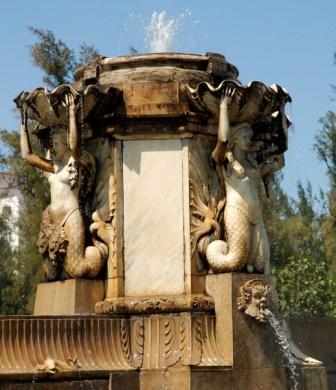Havana Neighborhoods, Two Extremes
Daisy Valera

I’m a nomad; I drag my things from place to place (though I’m not the only one).
I’ll stay over at the house of some friend or I’ll rent a floor (always expensive) for the short time that it’s owners allow me.
I got tired of living surrounded by grandparents, parents, and brothers and sisters. I got tired of the little bit of space that condemned me to that canned sardine feeling.
Now I live in the far-eastern suburb of Alamar.
And, as if I were destined to never to forget to compare, they’ve sent me to complete my social service obligation in the far western suburb of Miramar.
Every morning I climb up into the green bus from my job that swings by to swallow me and the others up at 6:30, only to spit us all out an hour and twenty minutes later — if we’re lucky — on the other side of town.
In that journey, I only have to travel 80 minutes to find myself in that western paradise, because Miramar was built by the Cuban upper class prior to 1959, and the aesthetics of its 5th Avenue make one feel that they’re in Manhattan, albeit with a tropical sun.
This residential area has plenty of parks with arbors and leafy trees.
Also located in Miramar is one of the country’s largest Catholic churches and the nation’s most modern theme park (formerly Coney Island)
Along with the embassies, Miramar has blocks of mansions where some Cubans also live – keeping their gardens green and their statues clean.
They enjoy the comforts of those who went to the United States, those who were previously our class enemies but are now practically the example to emulate.
In the large eclectic houses of this quarter are plenty of domestic employees and nannies.
Parents don’t take their children to public daycare centers but to private sitters, to where they drive back at 5:00 in the afternoon to pick their kids up.
Toyotas, Audis and Mercedes with private license plates fly along the avenues, and at the wheels you can see young trim faces.
Alamar is the other side of the coin. The neighborhood that should have been the pride of the architecture generated by the revolution is the sprawling project to which I return every night to eat and sleep.

The buildings replicate each other, one after another, gracelessly, each full of cracks and chronic leaks, and with the highest ones displaying their filthy basements and broken glass windows.
There are still streets that haven’t been paved out here, and the weeds have taken over the sidewalks.
This, the “Workers City,” is an unfinished dream where the expansive plots on which movie theaters were once planned are now overgrown, and where today you find only huge empty markets and closed warehouses.
This neighborhood, an homage to prefabricated apartment blocks and architectural “egalitarianism,” an insult to good taste and diversity.
It’s a place where it’s difficult to get bread and where water comes through the tap only twice a day.
It’s a bedroom community from which it’s often impossible to leave and where you can’t find a restaurant or a place for recreation – other than some corner where reggaeton is blasting.
Alamar and Miramar: two neighborhoods that reflect the social classes that exist on this island – one whose members can’t make enough to survive and the other whose constituents live with their hands way too full, squandering everything.
…small slices of the city resembling each other only through the endings of their names and their closeness to the sea.





I wonder what’s the Cuban GINI coefficient nowadays. From the Revolution up to the 80’s the index decreased from 0.55 to 0.22 – http://berclo.net/page01/01en-gini-coef.html. I suppose it’s higher now, but I have no clue of how much.